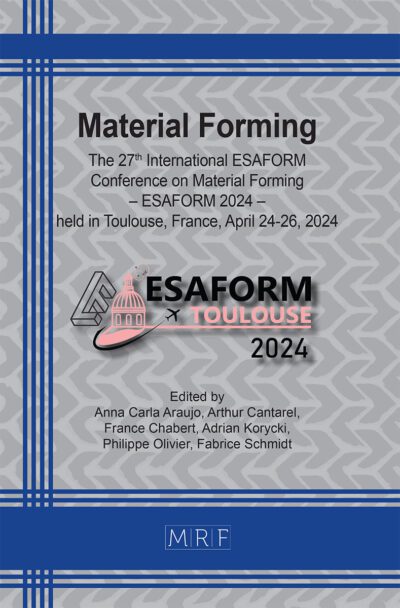Glass4AutoFuture: Modeling thermal-mechanical dynamics in vacuum-assisted deep drawing of 3D thin glass components for automotive interiors
Anh Tuan VU, Constantin MEINERS, Skadi BÖGERSHAUSEN, Cornelia ROJACHER, Tim BREPOLS, Stefanie REESE, Thomas BERGS
Abstract. The future of mobility is being shaped by autonomous, electrified, and energy-efficient vehicles, with glass increasingly replacing traditional materials like metals and polymers due to its lightweight, durable, and aesthetically appealing characteristics. Meeting the rising demand for complex shapes, high precision, and cost-efficient production of glass components in the automotive industry requires innovative processing technologies. This work presents a vacuum-assisted deep drawing process for manufacturing thin glass display covers for automotive interiors. To address challenges in thin glass forming, such as glass thinning, edge wrinkles, and shape accuracy, a numerical simulation model was developed. The model integrates the thermal and mechanical aspects of glass and molding tool materials, focusing on the viscoelastic behavior of glass at high forming temperatures. A finite strain material model accounts for time, temperature, and strain rate dependencies, while nonlinear thermal-mechanical interactions at the glass-tool interface are captured using a novel method for simultaneously determining contact heat transfer and friction coefficients. Experimental validation demonstrated the model’s ability to achieve high precision, reduce glass failures, and reliably optimize the process. By identifying critical factors influencing glass thinning, this research offers valuable insights into advancing thin glass processing technologies to meet the precision demands of future automotive applications.
Keywords
Thin Glass Forming, Finite Viscoelasticity, Friction, Contact Heat Transfer
Published online 5/7/2025, 10 pages
Copyright © 2025 by the author(s)
Published under license by Materials Research Forum LLC., Millersville PA, USA
Citation: Anh Tuan VU, Constantin MEINERS, Skadi BÖGERSHAUSEN, Cornelia ROJACHER, Tim BREPOLS, Stefanie REESE, Thomas BERGS, Glass4AutoFuture: Modeling thermal-mechanical dynamics in vacuum-assisted deep drawing of 3D thin glass components for automotive interiors, Materials Research Proceedings, Vol. 54, pp 1323-1332, 2025
DOI: https://doi.org/10.21741/9781644903599-144
The article was published as article 144 of the book Material Forming
![]() Content from this work may be used under the terms of the Creative Commons Attribution 3.0 license. Any further distribution of this work must maintain attribution to the author(s) and the title of the work, journal citation and DOI.
Content from this work may be used under the terms of the Creative Commons Attribution 3.0 license. Any further distribution of this work must maintain attribution to the author(s) and the title of the work, journal citation and DOI.
References
[1] Information on www.pwc.com/gx/en/industries/automotive/publications/eascy.html.
[2] Information on www.mckinsey.com/industries/automotive-and-assembly/our-insights/the-future-of-interior-in-automotive.
[3] A.T. Vu, P.-A. Vogel, O. Dambon, F. Klocke, Vacuum-assisted precision molding of 3D thin microstructure glass optics, in: S. Taccheo, M. Ferrari, J.I. Mackenzie (Eds.), Fiber Lasers and Glass Photonics: Materials through Applications, SPIE, 2018 – 2018, p. 11. https://doi.org/10.1117/12.2307060
[4] P.-A. Vogel, A.T. Vu, H. Mende, T. Grunwald, T. Bergs, R.H. Schmitt, Approaches and methodologies for process development of thin glass forming, in: B.L. Unger, J. DeGroote Nelson (Eds.), Optifab 2019, SPIE, 2019 – 2019, p. 68. https://doi.org/10.1117/12.2536431
[5] A.T. Vu, T. Grunwald, T. Bergs, Friction in glass forming: Tribological behaviors of optical glasses and uncoated steel near glass transition temperature, J. Non-Cryst. Solids 642 (2024) 123160. https://doi.org/10.1016/j.jnoncrysol.2024.123160
[6] Information on www.continental.com/en/press/press-releases/2018-01-04-3d-touch-display/.
[7] A.T. Vu, Modeling Relaxation Nature of Nonequilibrium Glass in Nonisothermal Glass Molding, Dissertation, 2023. https://publications.rwth-aachen.de/record/977936
[8] A.T. Vu, A.N. Vu, T. Grunwald, T. Bergs, Modeling of thermo‐viscoelastic material behavior of glass over a wide temperature range in glass compression molding, J Am Ceram Soc 103 (2020) 2791-2807. https://doi.org/10.1111/jace.16963
[9] A.T. Vu, R.d.l.A. Avila Hernandez, T. Grunwald, T. Bergs, Modeling nonequilibrium thermoviscoelastic material behaviors of glass in nonisothermal glass molding, J Am Ceram Soc 105 (2022) 6799-6815. https://doi.org/10.1111/jace.18605
[10] S. Bögershausen, H. Holthusen, S. Felder, T. Brepols, A.T. Vu, T. Grunwald, S. Reese, A novel thermo‐mechanically coupled material model for glass above the glass transition temperature, Proc Appl Math and Mech 23 (2023). https://doi.org/10.1002/pamm.202300150
[11] T.D. Pallicity, A.T. Vu, K. Ramesh, P. Mahajan, G. Liu, O. Dambon, Birefringence measurement for validation of simulation of precision glass molding process, J Am Ceram Soc 100 (2017) 4680-4698. https://doi.org/10.1111/jace.15010
[12] A.T. Vu, A novel method to investigate tribological behaviors under transient temperatures using Pin-on-Cylinder tribometer and IR-thermography in glass forming, in: Material Forming: ESAFORM 2024, Materials Research Forum LLC, 2024, pp. 1315-1324.
[13] W.A. Jonker, S. Kuiper, F. Kamphues, P.-A. Vogel, A.T. Vu, C. Meiners, R. ter Horst et al., Hot forming of a large deformable mirror facesheet, in: R. Geyl, R. Navarro (Eds.), Advances in Optical and Mechanical Technologies for Telescopes and Instrumentation V, SPIE, 2022, pp. 25. https://doi.org/10.1117/12.2629810
[14] G. Liu, A.T. Vu, O. Dambon, F. Klocke, Glass Material Modeling and its Molding Behavior, MRS Advances 2 (2017) 875-885. https://doi.org/10.1557/adv.2017.64













